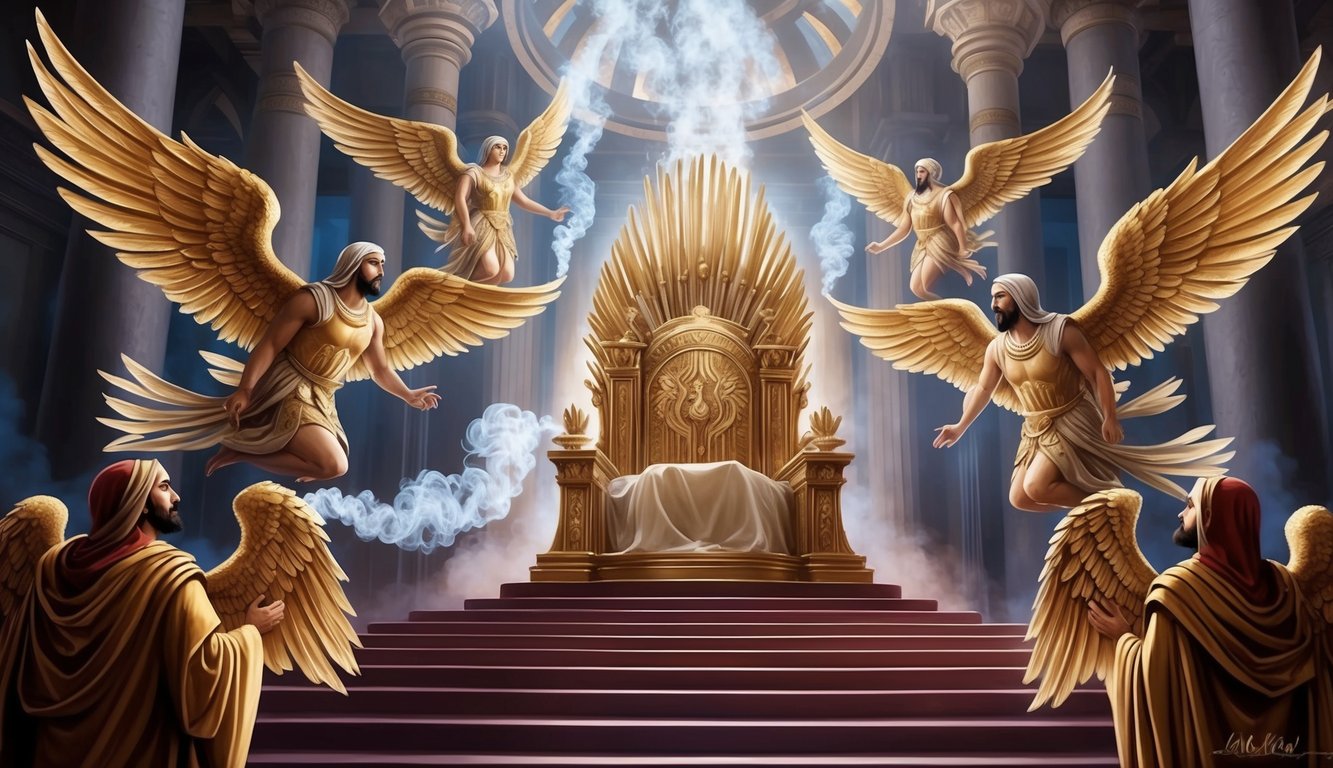Don’t Miss Out On This Unique Astrological Opportunity
Are you tired of spinning your wheels and getting nowhere? Simply put, you’re out of sync: you’re out of alignment with your astral configuration.
But: there’s a kind of map that can help you reclaim your alignment. Think of it as your own personal blueprint to success and happiness: a blueprint that will help you live your most amazing life.
Get started here.
Imagine a vision so powerful that it changes your life forever.
In Isaiah 6, the prophet Isaiah experiences just that.
He sees the Lord Almighty seated on a magnificent throne, surrounded by angelic beings, and hears their eternal song, “Holy, Holy, Holy.” This awe-inspiring moment marks the beginning of Isaiah’s mission as a prophet, tasked with delivering messages of both judgment and hope to the people.
Isaiah’s vision is not just a personal experience; it has profound significance for readers today. Isaiah 6 offers insights into the nature of God’s holiness and the idea of being called for a purpose. When Isaiah witnesses God’s glory, he also realizes his own shortcomings.
This illustrates a theme of confession and redemption that resonates deeply with many people.
As you explore the passage, you’ll discover themes that encourage reflection on your own life and beliefs.
Isaiah’s story invites you to consider how divine encounters and moments of clarity can lead to transformative actions and a deeper faith.
Key Takeaways
- Isaiah’s vision highlights the holiness of the Lord.
- The chapter presents themes of judgment and hope.
- Personal transformation is a key message in Isaiah 6.
Isaiah’s Vision and Its Significance
Isaiah’s vision marked a pivotal moment in his life and prophetic ministry.
It revealed the majesty of the Lord and highlighted the contrast between divine holiness and human sinfulness.
The Lord on the Throne
In the year King Uzziah died, you learn about Isaiah’s encounter with the Lord in the temple.
He saw the Lord sitting upon a throne, high and exalted, which underscores divine glory and authority.
This scene is powerful, as the Lord’s robe fills the temple, showing his immense presence.
You can imagine the earth shaking and smoke filling the air, creating an atmosphere of awe and reverence.
The voice from the throne brings attention to the holiness of God, proclaiming, “Holy, holy, holy.” This highlights the perfection and majesty that sets God apart.
Such an encounter emphasizes the call to recognize the divine nature of the Lord and the vast gap between earthly imperfection and heavenly purity.
Seraphim and the Act of Purification
You discover the seraphim, angelic beings with six wings.
They cover their faces and feet, showing humility in God’s presence, and fly as they serve Him.
The seraphim sing praises, echoing the holiness of the Lord.
In a dramatic act, one seraphim uses a live coal from the altar to touch Isaiah’s lips.
This symbolizes the purification of his “unclean lips” and the atonement of his sin.
It’s a vivid image of redemption and preparation for prophetic service, turning Isaiah from sinner to messenger.
The act of cleansing not only signifies personal transformation but also reinforces the holy seed, a key symbol of purity and divine connection.
The Message of Judgment and Hope
Isaiah 6 presents a powerful vision of Isaiah’s calling, centered on God’s holiness and the people’s stubbornness.
The chapter outlines Isaiah’s mission to deliver a message of both judgment and the promise of future hope, highlighting themes like healing, justice, and righteousness.
Isaiah’s vision in this chapter emphasizes God’s supreme authority and the transformative power of divine encounters.
Despite the people’s resistance, Isaiah remains committed to his prophetic mission, reinforcing the tension between human frailty and divine holiness.
This theme is further explored in passages like Isaiah 57 meaning, which delves into God’s mercy and the path to spiritual renewal for the contrite heart.
Isaiah’s Commission
In this powerful moment, Isaiah stands before the Lord.
God is surrounded by seraphim, emphasizing His holiness.
You hear God asking, “Whom shall I send?” Isaiah’s response is clear: “Here am I. Send me!” He’s tasked with delivering a sobering message to the people.
They will hear his words, but their hearts will remain hard.
Despite the difficulty, Isaiah must go, making it clear that true understanding and change come from being open to God’s voice.
The Hardness of People’s Hearts
The people’s hearts are described as resistant.
Isaiah’s task is to tell them that they will be “ever hearing, but never understanding,” and “ever seeing, but never perceiving.” This reflects a deep spiritual blindness.
Cities lie desolate and houses without inhabitants, showing the extent of their stubbornness.
Despite Isaiah’s warnings, many choose not to see love and hope offered by God.
The Remnant and Restoration
Amid the message of judgment, there is hope.
God speaks of a remnant, a “holy seed.” Although the land will be stripped bare, like a terebinth or oak with only a stump left, this stump represents new beginnings.
This “tenth” will carry forward God’s promise for renewal.
Through this remnant, restoration is possible.
Justice and righteousness will flourish again, showing that even in judgment, God’s love prevails.
Theological Themes and Interpretation

In Isaiah 6, you find themes of sin and guilt woven throughout the story.
Isaiah’s vision reveals how people are sometimes aware of their own imperfections, symbolized by the phrase “man of unclean lips.” This acknowledgment brings to light the need for cleansing and transformation.
The phrase “Holy, Holy, Holy” speaks to God’s purity and perfection.
It emphasizes how far humans are from God’s holiness because of their sinful nature.
When you hear “the whole earth is full of His glory,” it reminds you that God’s presence is vast and encompassing, despite human sin.
Some people might become calloused and unfeeling, with hearts that are dull to God’s message.
This theme reflects how people may ignore or turn away from divine truths, making it important to remain open and receptive.
Isaiah’s encounter with God’s throne room captures a moment of deep impact.
Angelic beings, like seraphim, play a crucial role in this experience, ministering and demonstrating God’s holiness.
Reading different commentaries on this passage can give you various insights into why these scenes carry profound theological importance.
When you explore these themes, remember they are not just ancient ideas.
They challenge you to consider your own spiritual state, showing the importance of being attentive to God’s voice and His transformative power in your life.
Frequently Asked Questions

Isaiah 6 is a significant chapter in the Bible, full of imagery and meaning.
You’ll discover how translations interpret its verses, understand the role of the seraphim, and grasp Isaiah’s call and its theological significance.
What does the vision described in Isaiah chapter 6 represent?
Isaiah 6 portrays a profound vision where Isaiah sees God on His throne.
This represents God’s majesty and holiness.
The imagery of the temple and heavenly creatures reinforces the themes of divine sovereignty and the awe-inspiring presence of God.
It’s a vivid reminder of God’s greatness.
How do different Bible translations like KJV, NIV, ESV, and NASB interpret Isaiah 6?
Different translations like the KJV, NIV, ESV, and NASB have slight variations in language.
They capture the majesty of God’s appearance and Isaiah’s reaction.
These versions aim to convey the depth of Isaiah’s experience, while maintaining the core message of God’s holiness and Isaiah’s sense of unworthiness.
Can you provide commentary insights on the meaning of Isaiah 6?
Commentary on Isaiah 6 often highlights Isaiah’s recognition of his own sinfulness when confronted with God’s holiness.
The passage emphasizes the need for purification and preparation for God’s service.
Commentary might also discuss Isaiah’s calling and the implications of his vision for his prophetic mission.
How is the call of Isaiah in Isaiah 6:8 understood within Christian theology?
Isaiah 6:8 is famous for Isaiah’s response to God’s call, “Here am I. Send me!” In Christian theology, this is seen as an example of obedience and willingness to serve God.
It emphasizes the readiness to accept God’s mission despite personal inadequacies.
What are the implications of the seraphim’s actions towards Isaiah in chapter 6?
The seraphim’s actions, such as touching Isaiah’s lips with a live coal, are symbolic of purification and atonement.
This act signifies the cleansing of Isaiah’s sins, preparing him for his prophetic role.
It illustrates God’s grace in forgiving and equipping those He calls to serve.
How does Isaiah 6 contribute to the overall message of the Book of Isaiah?
Isaiah 6 is foundational to the book’s themes of holiness, judgment, and redemption.
It sets the stage for Isaiah’s prophetic ministry.
The chapter highlights the contrast between human imperfection and divine perfection, serving as a call to faithfulness and trust in God’s ultimate plan.



